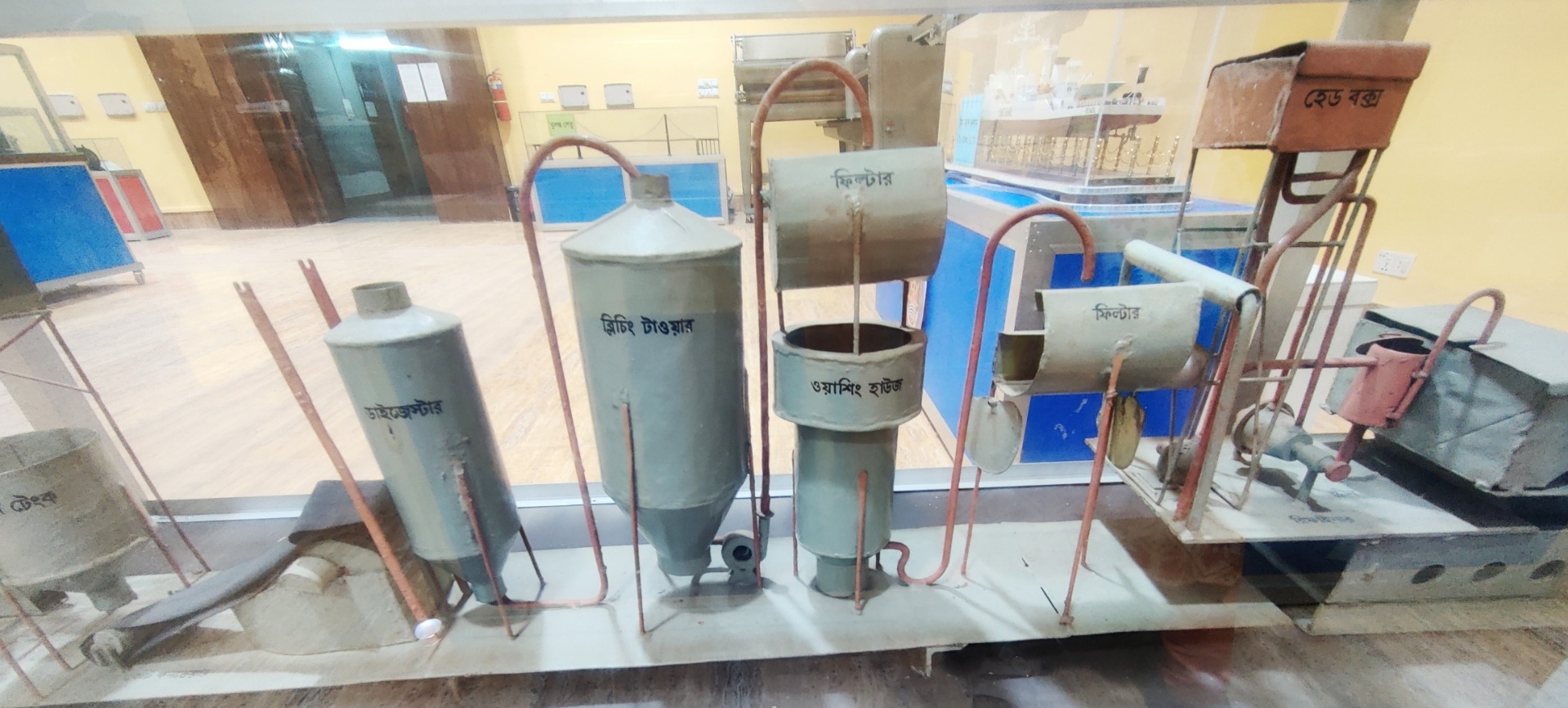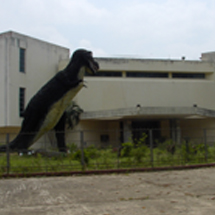সর্ব-শেষ হাল-নাগাদ: ৩rd জুন ২০২২
কাগজ কলের মডেল
আমাদের দেশে বাঁশ, কাঠ, আখের ছোবড়া, নলখাগড়া দিয়ে কাগজ তৈরি করা হয়। প্রথমে বাঁশ বা কাঠকে চিপারে ফেলা হয়। এখানে কাঠ কেটে ছোট ছোট টুকরা করা হয়। বেল্টের সাহায্যে এ টুকরোগুলি ডাইজেস্টারে নেয়া হয়। ডাইজেস্টারে উচ্চ তাপমাত্রা ও চাপে সোডিয়াম হাইড্রোক্সাইড, সোডিয়াম আয়োডাইড,সোডিয়াম বাই সালফেট পূর্ণ কুকিং লিটারের সাথে সিদ্ধ করা হয়। এখান থেকে মণ্ডকে পাম্প করে বের করা হয় এবং ধৌত ও বিরঞ্জন করা হয়। বিরঞ্জক হিসেবে ক্যালসিয়াম হাইপোক্লোরাইড দ্রবণে চুনের পানি ব্যবহার করা হয়। এরপর মন্ডকে রিফাইনার বা বিটারের ভেতরে চালনা করা হয়। উচ্চমানের কাগজের জন্য বিটার ও রিফাইনার দুইটাই ব্যবহার করা হয়। মসৃণ তল ও অধিকতর সাদা কাগজের জন্য এখানে মন্ডের সাথে চুনীকৃত ট্যালকা অথবা কাদামাটি অধঃক্ষিপ্ত (ক্যালসিয়াম কার্বনেট) যোগ করা হয়। এছাড়া কাগজে তরল দ্রব্য প্রবেশ রোধের জন্য সাইজিং সোবান ও ফিটকিরি ব্যবহার করা হয়। এরপর মন্ড রোলারের মধ্য দিয়ে চালনা করা হয়। এতে কাগজ প্রস্তুত সম্পন্ন হয়।

The paper is made in our country with ingredients like bamboo, wood, bagasee and nalkhagra. At first the ingredients are fall down int chipper for making them into tiny fragments. These fragments are then transferred into the digester though belt. The fragments are then cooked with NaOH, Nal and Na2S at elevated pressure and temperature. From here, the pulp is pumped out to next stage. Then the pulpis washed away and decolourised. As decolourising agents, calciumhypochloride solution or chlorine and limewater are used. After this, the pulp is driven through refiner/beater. For better quality paper, the pulp is driven through both beter and refiner. For fine and whiter paper, talc powder or precipitation of clay (CaCO3) is added with the pulp. Besides these, sizing soap and patashalum are added to prevent the penetration of liquid into the paper. Then the pulp is passed through rollers. The paper is produced after dong this.
সর্বশেষ খবর
পবিত্র ঈদ-উল-ফিতর, ২০২৫ উপলক্ষে আগামী ২৭ মার্চ ২০২৫ থেকে ৪ এপ্রিল ২০২৫ তারিখ পর্যন্ত জাতীয় বিজ্ঞান ও প্রযুক্তি জাদুঘরের গ্যালারী প্রদর্শনী কার্যক্রম বন্ধ থাকবে।
Array
(
[id] => 7940452d-2f6d-4e42-8f87-8afb3227ed08
[version] => 63
[active] => 1
[publish] => 1
[created] => 2015-01-25 15:58:17
[lastmodified] => 2024-11-03 13:26:54
[createdby] => 136
[lastmodifiedby] => 2598
[domain_id] => 6414
[office_id] =>
[menu_id] =>
[title_bn] => মহাপরিচালক
[title_en] => Director General
[body_bn] =>
[body_en] =>
[userpermissionsids] =>
[uploadpath] => e9005938-c62a-4cda-bdf2-fb21556182fc
[userip] => 127.0.0.1
[useragent] => Mozilla/5.0 (Windows NT 10.0; Win64; x64) AppleWebKit/537.36 (KHTML, like Gecko) Chrome/130.0.0.0 Safari/537.36
[usergeo] =>
[is_right_side_bar] => 1
[office_head_photo] => Array
(
[0] => Array
(
[name] => 2024-11-03-07-22-6b2a72f3355ff271bf2bf600fddeeab8.jpg
[caption_bn] => মহাপরিচালক
[caption_en] => Director General
[link] =>
)
)
[office_head_description] => মহাপরিচালক
[office_head_des_bn] => মুনীরা সুলতানা এনডিসি
মুনীরা সুলতানা এনডিসি, অনানুষ্ঠানিক বিজ্ঞান শিক্ষা কার্যক্রমের মাধ্যমে একটি বিজ্ঞানমনস্ক জাতি গঠনের লক্ষে ৩১ অক্টোবর, ২০২৪খ্রিঃ তারিখে জাতীয় বিজ্ঞান ও প্রযুক্তি জাদুঘরের মহাপরিচালক হিসেবে দায়িত্ব গ্রহণ করেন।
তিনি ১৯৯৩ সালে বাংলাদেশ সিভিল সার্ভিস প্রশাসন ক্যাডারে যোগদানের মধ্য দিয়ে কর্মজীবন শুরু করেন। তিনি বেশিরভাগ সময় বিভিন্ন মন্ত্রণালয় ও অধিদপ্তরে এবং মাঠ প্রশাসনে দায়িত্ব পালন করেন। ঢাকা বিশ্ববিদ্যালয় থেকে উদ্ভিদবিদ্যা বিভাগ থেকে তিনি স্নাতকোত্তর ডিগ্রি অর্জন করেন। চাকরিতে কর্মরত অবস্থায় তিনি নর্দান ইউনিভার্সিটি, ঢাকা থেকে গভর্নেন্স স্টাডিজ বিষয়ে দ্বিতীয় স্নাতকোত্তর ডিগ্রি অর্জন করেন। তিনি ২০১৮ সালে ন্যাশনাল ডিফেন্স কলেজ থেকে ন্যাশনাল ডিফেন্স কোর্স সাফল্যের সাথে সম্পন্ন করেন।
চাকুরিরত অবস্থায় তিনি দেশে এবং বিদেশে বিভিন্ন পেশাগত প্রশিক্ষণ কোর্স সাফল্যের সাথে সম্পন্ন করেন। একটি বিজ্ঞানমনস্ক জাতি গঠনে এবং সারা দেশে বিজ্ঞান ও প্রযুক্তির সুফল ছড়িয়ে দিতে তিনি নিরলস কাজ করে যাচ্ছেন।
[office_head_des_en] => Munira Sultana ndc
Munira Sultana ndc, took charge as Director General of National Museum of Science and Technology on October 31, 2024 with the aim of building a science minded nation through informal science education programs.
She started her carrier in the Bangladesh Civil Service administration cadre in 1993. She served mostly in field administration and different ministries and directorate. She earned her degree of M.Sc. in Botany from the University of Dhaka. While in service, she earned a second Masters degree in Governance Studies from the Northern University, Dhaka. She completed the National Defense Course successfully in 2018 from National Defense College.
She acquired various professional training courses during her service period in home and abroad and keenly interested in building a science minded nation and spread the blessings of Science and Technology across the country.
[designation] =>
[designation_new_bn] => মহাপরিচালক
[designation_new_en] => Director General
[weight] => 0
)
=======================
কেন্দ্রীয় ই-সেবা
পথ নির্দেশিকা

হটলাইন

সামাজিক যোগাযোগ

জরুরি হেল্পলাইন নম্বর




.jpg)













